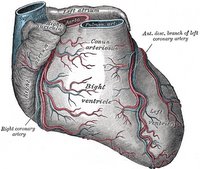 Traditional CHD risk factors used in the Framingham risk score (FRS) predictions include:
Traditional CHD risk factors used in the Framingham risk score (FRS) predictions include:- age
- gender
- systolic blood pressure
- treatment of hypertension
- total and high-density lipoprotein cholesterol levels
- smoking
- diabetes
The newer CHD risk factors include:
- N-terminal fragment of prohormone B-type natriuretic peptide levels
- von Willebrand factor antigen levels
- fibrinogen levels
- chronic kidney disease
- leukocyte count
- C-reactive protein levels
- homocysteine levels
- uric acid levels
- coronary artery calcium [CAC] scores
- carotid intima–media thickness
- peripheral arterial disease
- pulse wave velocity
Adding coronary artery calcium [CAC] scores to the FRS improved the accuracy of risk predictions.
Levels of N-terminal fragment of prohormone B-type natriuretic peptide also improved risk predictions but to a lesser extent.
Improvements in predictions with other newer markers were marginal.
References:
Evaluation of Newer Risk Markers for Coronary Heart Disease Risk Classification: A Cohort Study. Maryam Kavousi et al. Ann Intern Med. 20 March 2012;156(6):438-444.
Image source: Gray's Anatomy, 1918, public domain.
Comments from Twitter:
Michael Mirochna, MD @DocRockne: unfortunately, no evidence they help with OUTCOMES
Hiç yorum yok:
Yorum Gönder